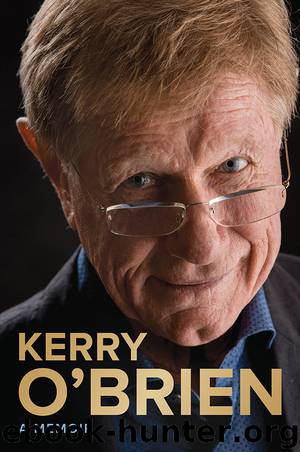Kerry O'Brien by Kerry O'Brien

Author:Kerry O'Brien
Language: eng
Format: epub
Publisher: Allen & Unwin
Published: 2018-09-24T16:00:00+00:00
Unlike the remarkable intensity of the 1993 Keating–Hewson campaign where Paul Keating managed to move the battlefield away from his own vulnerabilities and on to John Hewson’s fatal weakness—the GST—converting certain defeat into ‘victory for the true believers’, 1996 was the opposite. Keating threw everything at Howard, but he and his senior colleagues were unfazed and stuck to their script.
When the campaign began there was barely a political observer in the country who believed Keating had a snowflake’s chance in hell of winning. That had also been pretty much the case in 1993, but the battle-hardened, politically wily John Howard was a much more elusive target than John Hewson. In 1993, Keating was always behind in the polls but never as far behind as he was against Howard. Four days before Keating called the 1996 election on 27 February, The Australian’s Newspoll gave a ten-point lead to Howard in two-party preferred terms, an almost impossible lead to peg back in a four- or five-week campaign.
Both leaders were edgy when I interviewed them around the middle of the campaign. A number of private sector economists had written that Labor’s budget deficit would be bigger than Treasury forecasts, therefore calling into question Keating’s economic credibility and John Howard’s spending promises. Howard had finally released some costing details of his promises, and on the day I was to interview Keating Finance minister Kim Beazley had jumped on them, calling a press conference to claim a $3 billion shortfall in Howard’s calculations. Howard had made a fatal mistake in that regard as leader back in the 1987 campaign and Keating was attempting to tar him again with the same brush. Unfortunately for Beazley, and Labor’s strategy, journalists were much more interested in pursuing him about the true state of the budget deficit than Howard’s figures.
Beazley was shaky in rejecting the demand for updated Treasury figures on the deficit as being too difficult for Treasury to calculate in the time available, because every journalist knew that on the day after the election the head of Treasury, as a matter of form, would have a brief ready for his new prime minister and treasurer, including an updated estimate of the budget deficit. That was exactly what had happened in 1983 when the head of Treasury, John Stone, had handed over a brief to the newly elected Hawke government showing a big jump in the Fraser government’s budget deficit with John Howard as treasurer. Hawke and Keating immediately recanted on some of their election promises, on the basis that to proceed in light of this shocking news would be the height of fiscal irresponsibility. And Treasury would have that same set of papers ready for the new government on the day after the 1996 election.
That, of course, was the question I asked Paul Keating that night:
KOB: If it was possible in ’83 for those [deficit] figures to be made available, then why isn’t it possible for similar updates to be made available now?
PK: Well, for the first
Download
This site does not store any files on its server. We only index and link to content provided by other sites. Please contact the content providers to delete copyright contents if any and email us, we'll remove relevant links or contents immediately.
| Military | Political |
| Presidents & Heads of State | Religious |
| Rich & Famous | Royalty |
| Social Activists |
Waking Up in Heaven: A True Story of Brokenness, Heaven, and Life Again by McVea Crystal & Tresniowski Alex(37675)
Empire of the Sikhs by Patwant Singh(22974)
We're Going to Need More Wine by Gabrielle Union(18969)
Hans Sturm: A Soldier's Odyssey on the Eastern Front by Gordon Williamson(18485)
Leonardo da Vinci by Walter Isaacson(13184)
The Radium Girls by Kate Moore(11921)
Tools of Titans by Timothy Ferriss(8218)
Educated by Tara Westover(7941)
How to Be a Bawse: A Guide to Conquering Life by Lilly Singh(7393)
Permanent Record by Edward Snowden(5738)
The Last Black Unicorn by Tiffany Haddish(5558)
The Rise and Fall of Senator Joe McCarthy by James Cross Giblin(5229)
Promise Me, Dad by Joe Biden(5087)
The Wind in My Hair by Masih Alinejad(5034)
A Higher Loyalty: Truth, Lies, and Leadership by James Comey(4845)
The Crown by Robert Lacey(4723)
The Iron Duke by The Iron Duke(4292)
Joan of Arc by Mary Gordon(4014)
Stalin by Stephen Kotkin(3875)
